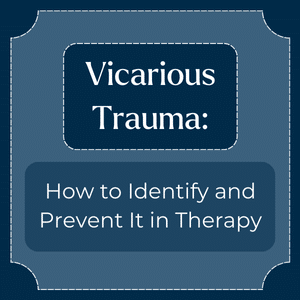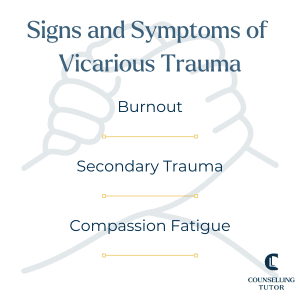Download FREE Handout
Vicarious Trauma: How to Identify and Prevent It in Therapy
The following article is taken from our Trauma-Informed Practice course.
Vicarious trauma is a significant concern for counsellors working in close contact with traumatised individuals. Indeed, the Diagnostic and Statistical Manual of Mental Disorders (APA, 2013, p. 271) includes therapists working with trauma in its list of people who might develop post-traumatic stress disorder (PTSD).
This article explores the concept of vicarious trauma, its risk factors, symptoms, and the importance of self-care strategies for counsellors and psychotherapists in their practice.
Vicarious Trauma: How to Identify and Prevent It in Therapy

The term refers to the profound psychological impact experienced by those who work with victims of trauma. McCann and Pearlman (1990, p. 131) define vicarious traumatisation as follows:
Persons who work with victims may experience profound psychological effects, effects that can be disruptive and painful for the helper and can persist for months or years after work with traumatized persons. We term this process ‘vicarious traumatization’.
Vicarious trauma is not limited to therapists but includes a broad spectrum of professionals, e.g. police officers, paramedics, firefighters and doctors. These individuals may experience disruptive and painful psychological effects, which can last for extended periods.
Several factors can increase the risk of vicarious trauma:
Recognising the signs early is crucial for timely intervention. The key indicators include:

Other symptoms can manifest as intrusions (e.g. flashbacks and nightmares), avoidance behaviours (e.g. avoiding clients and topics that trigger trauma) and hyperarousal (e.g. sleeplessness and hypervigilance).
A critical step in managing vicarious trauma is acknowledging its presence. Often, those affected are the last to recognise it. Ethical frameworks in counselling highlight the importance of self-care, as an unwell therapist cannot support clients effectively. Feedback from colleagues and supervisors is invaluable, as they may notice the signs and symptoms before the individual does.
Effective self-care strategies are essential in mitigating the impacts of vicarious trauma:
If you are a counsellor in private practice, you must evaluate the number of traumatised clients that you can manage effectively. Overburdening yourself can lead to significant negative outcomes. Taking breaks and slowing down practice when necessary can help maintain balance and health.
For agency managers, thoughtful client allocation is crucial. Regular check-ins with counsellors to assess their wellbeing and client load can prevent burnout and promote longevity in the profession. Ensuring that the organisation supports staff dealing with high levels of trauma is also vital.

Vicarious Trauma – How to Identify and Prevent It in Therapy
Understanding and managing vicarious trauma is vital for the wellbeing of practitioners working with traumatised individuals. By recognising the signs early, implementing effective self-care strategies, and fostering supportive professional environments, counsellors and psychotherapists can mitigate its impact and continue to provide high-quality care to their clients.
American Psychiatric Association. (2013). Diagnostic and Statistical Manual of Mental Disorders. 5th ed. Arlington, VA: American Psychiatric Publishing.
McCann, I. L., & Pearlman, L. A. (1990). Vicarious traumatization: A framework for understanding the psychological effects of working with victims. Journal of Traumatic Stress, 3, 131–149.
Pearlman, L. A., & Saakvitne, K. W. (1995). Trauma and the Therapist: Countertransference and Vicarious Traumatization in Psychotherapy with Incest Survivors. New York: W. W. Norton & Company.
Notice any broken link or issues with this resource? Kindly let us know by email
Email us